
Am Fam Physician. 2017;96(2):112-120
Related editorial: Refugee Mental Health: A Primary Care Approach.
Related article in the July/August 2017 issue of Family Practice Management: Building Capacity to Care for Refugees
Related letter: Screening and Immunizations for Refugees to the United States
Author disclosure: No relevant financial affiliations.
Since 1975, more than 3 million refugees have settled in the United States, fleeing unrest, conflict, and persecution. Refugees represent diverse ethnic, cultural, religious, socioeconomic, and educational backgrounds. Despite this heterogeneity, there are commonalities in the refugee experience. Before resettlement, all refugees must undergo an overseas medical screening to detect conditions that pose a potential health threat in the United States. On arrival, they should undergo an examination to detect diseases with high prevalence in their country of origin or departure. Refugees have higher rates of chronic pain compared with the general population, and their mental health and well-being are strongly influenced by their migration history. Refugees have higher rates of mood disorders, posttraumatic stress disorder, and anxiety than the general population. Some refugees have been tortured, which contributes to poorer health. Chronic noncommunicable diseases, such as diabetes mellitus and hypertension, are also prevalent among refugees. Many refugees may be missing routine immunizations and screenings for cancer and chronic diseases. Attention to reproductive health, oral health, and vision care will help identify and address previously unmet needs. Refugees face barriers to care as a result of cultural, language, and socioeconomic factors.
More than 65 million persons worldwide were forcibly displaced in 2015, a figure that the United Nations says is the highest level ever recorded and is likely to increase 1,2 (Table 1,3 and Figure 13 ). The United Nations defines a refugee as someone who, “owing to a well-founded fear of being persecuted for reasons of race, religion, nationality, membership of a particular social group, or political opinion, is outside the country of his nationality, and is unable to, or owing to such fear, is unwilling to avail himself of the protection of that country.” 4
| Clinical recommendation | Evidence rating | References |
|---|---|---|
| All refugees should have a medical screening examination within 30 days of arrival in the United States. | C | 11 |
| Physicians should consider whether refugees need assistance in overcoming barriers to health care. | C | 29–31, 33 |
| All refugee patients should be provided with a trained professional interpreter during physician visits, if necessary. | C | 11, 37 |
| Malaria should be considered in refugees from endemic regions who present with fever. | C | 11 |
| Physicians should assess for reactivation of latent tuberculosis in refugees who present with suggestive signs and symptoms, particularly in the first five years after resettlement. | C | 11, 27 |
| All refugees should be screened for depression, anxiety, and posttraumatic stress disorder. | C | 15 |
| Refugees should be screened for anemia, hypertension, impaired fasting glucose levels, micronutrient deficiencies, chronic pulmonary disease, and overweight or obesity. | C | 11–13, 16, 63–66 |
| Refugees without vaccine documentation should receive routine vaccinations except for varicella and hepatitis B, for which serologic testing is recommended or more cost-effective. | C | 11, 16 |
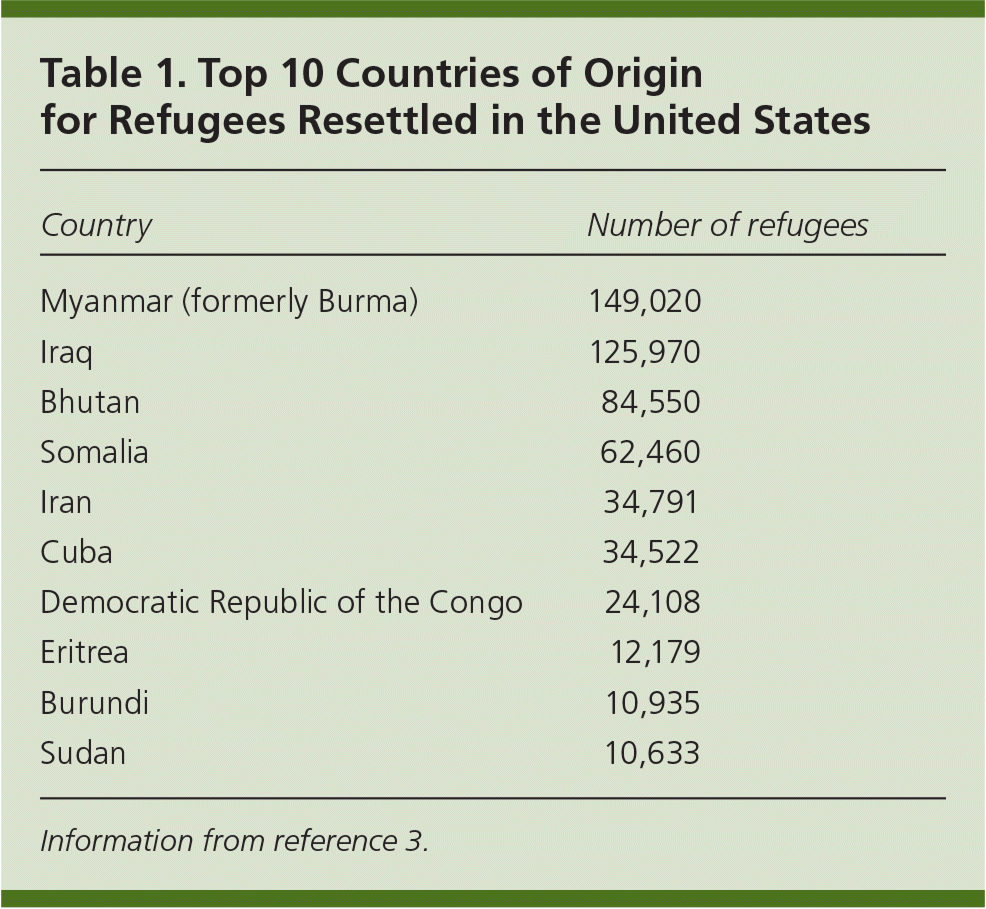
| Country | Number of refugees |
|---|---|
| Myanmar (formerly Burma) | 149,020 |
| Iraq | 125,970 |
| Bhutan | 84,550 |
| Somalia | 62,460 |
| Iran | 34,791 |
| Cuba | 34,522 |
| Democratic Republic of the Congo | 24,108 |
| Eritrea | 12,179 |
| Burundi | 10,935 |
| Sudan | 10,633 |
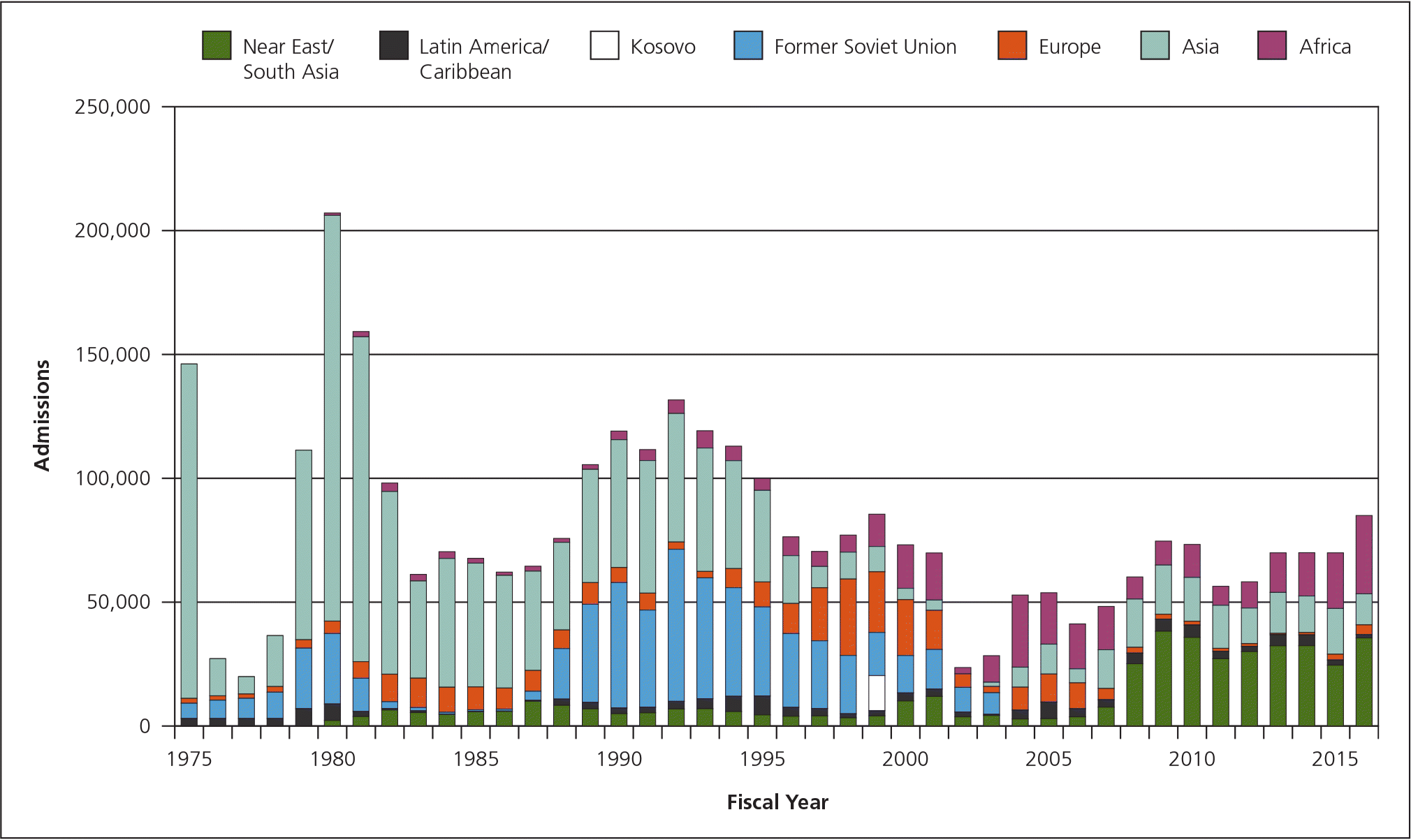
Since 1975, more than 3 million refugees have settled in the United States.5 Each year tens of thousands of refugees are admitted from select conflict areas as part of the U.S. State Department's sponsored resettlement program (Figure 2).3 The number was expected to increase to 100,000 in fiscal year 2017,6 but cuts have recently been proposed. Refugee status requests are processed overseas (often in refugee camps) by U.S. authorities in a process that may take up to two years.7 After being vetted and approved, refugees are connected to one of nine U.S.-based resettlement agencies for assistance with medical care, housing, language, and vocational training.
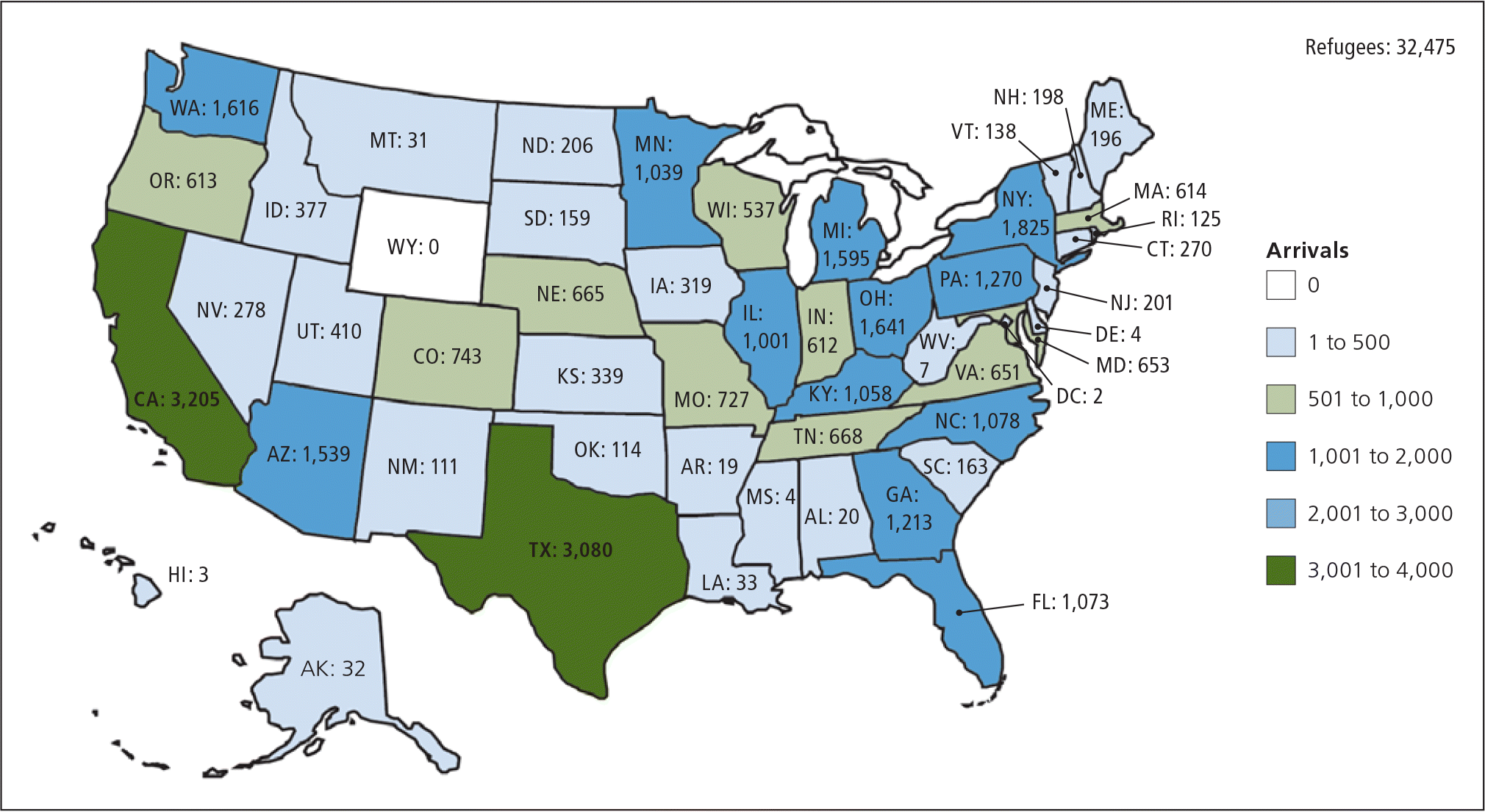
Refugees represent a diverse group of persons from different ethnic, cultural, religious, socioeconomic, and educational backgrounds. Despite this heterogeneity, there are commonalities among refugees that can affect health: adversity and trauma, resilience, displacement, migration, and resettlement. This article summarizes some of the issues commonly encountered in the primary care of refugee populations.
The Newly Arrived Refugee
When caring for newly arrived or former refugees, it is useful to consider their health status in three distinct phases: preflight, during flight/camp/predeparture, and at/after arrival (Table 2).8,9 These phases are associated with specific challenges, risks, and exposures, and can vary in length. Many refugees and their families may live in camps for decades before resettlement.
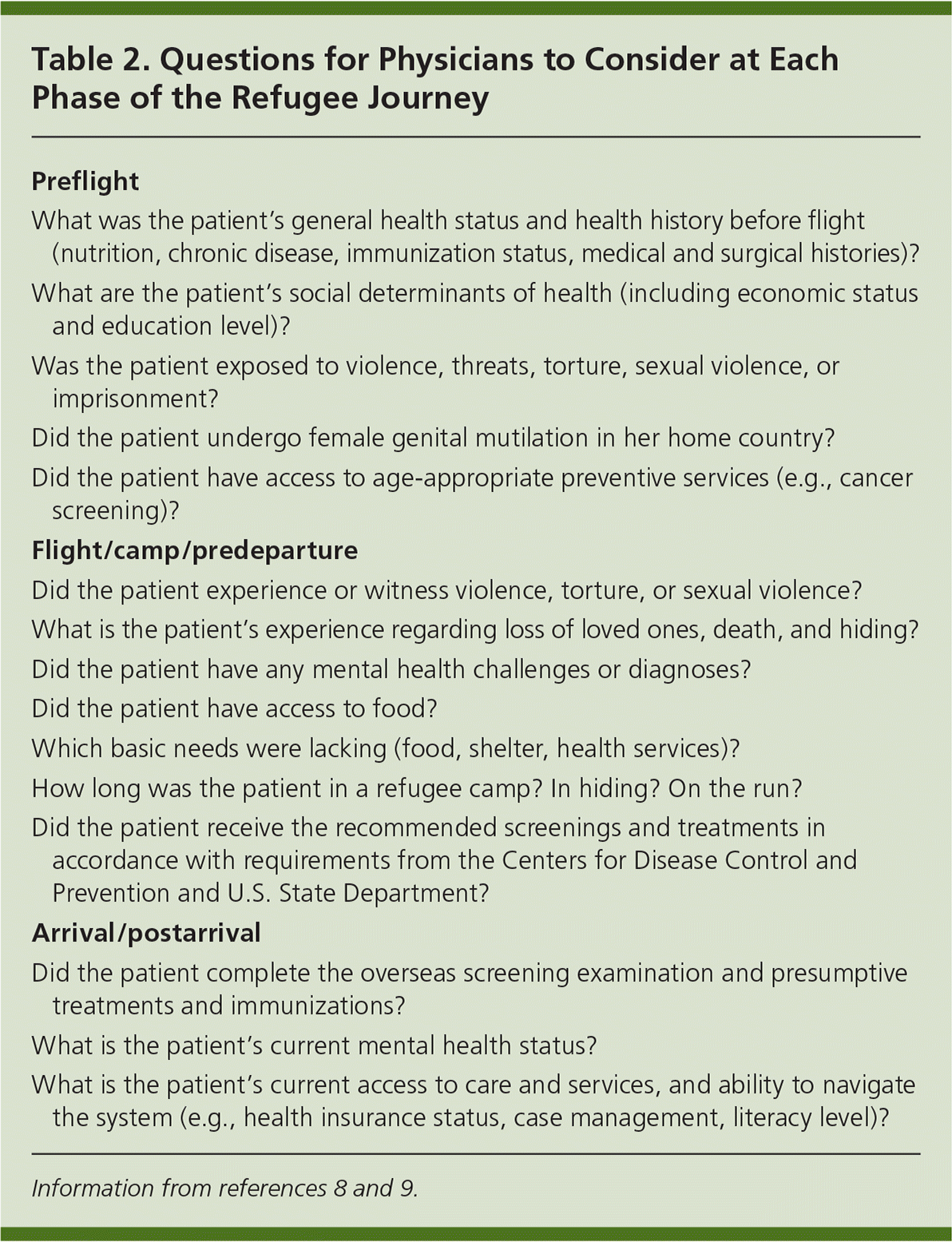
| Preflight |
| What was the patient's general health status and health history before flight (nutrition, chronic disease, immunization status, medical and surgical histories)? |
| What are the patient's social determinants of health (including economic status and education level)? |
| Was the patient exposed to violence, threats, torture, sexual violence, or imprisonment? |
| Did the patient undergo female genital mutilation in her home country? |
| Did the patient have access to age-appropriate preventive services (e.g., cancer screening)? |
| Flight/camp/predeparture |
| Did the patient experience or witness violence, torture, or sexual violence? |
| What is the patient's experience regarding loss of loved ones, death, and hiding? |
| Did the patient have any mental health challenges or diagnoses? |
| Did the patient have access to food? |
| Which basic needs were lacking (food, shelter, health services)? |
| How long was the patient in a refugee camp? In hiding? On the run? |
| Did the patient receive the recommended screenings and treatments in accordance with requirements from the Centers for Disease Control and Prevention and U.S. State Department? |
| Arrival/postarrival |
| Did the patient complete the overseas screening examination and presumptive treatments and immunizations? |
| What is the patient's current mental health status? |
| What is the patient's current access to care and services, and ability to navigate the system (e.g., health insurance status, case management, literacy level)? |
Before resettlement, all refugees undergo screening to detect conditions that may pose a public health threat in the United States10 (eTable A). This examination is performed overseas, following technical guidelines from the Centers for Disease Control and Prevention (CDC) with oversight from the U.S. State Department and the International Organization for Migration.11 Documentation from this examination is available to state and local health departments through the National Notifiable Diseases Surveillance System (http://www.cdc.gov/nndss/nedss.html). Recommendations for vaccination and empiric treatment of parasitic infections vary by countries of origin and departure. The CDC recommendations for predeparture vaccinations are available at http://www.cdc.gov/immigrantrefugeehealth/pdf/current-presumptive-immunization-schedules.pdf; recommendations for empiric treatment of parasitic infections are available at http://www.cdc.gov/immigrantrefugeehealth/pdf/intestinal-parasites-domestic.pdf.
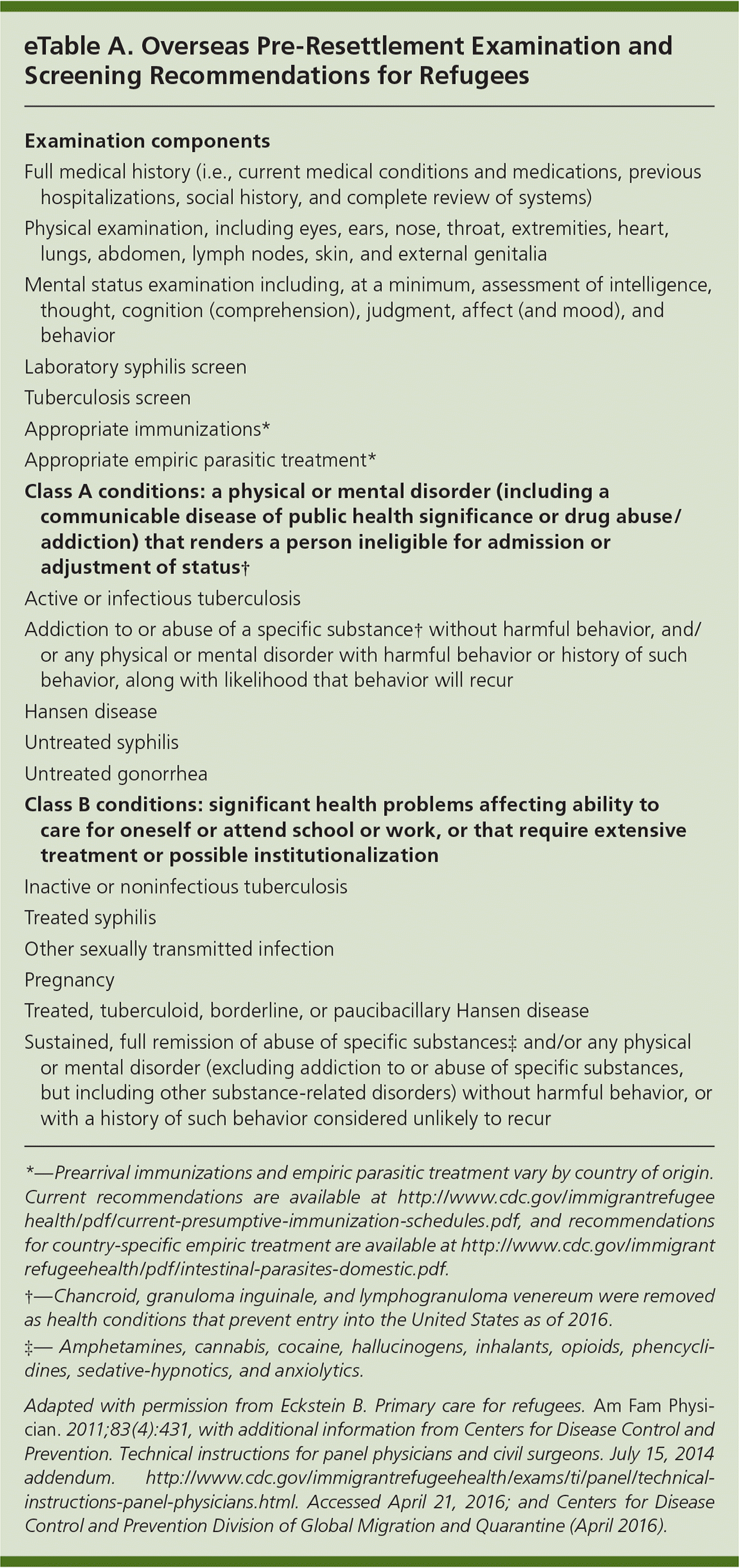
| Examination components |
| Full medical history (i.e., current medical conditions and medications, previous hospitalizations, social history, and complete review of systems) |
| Physical examination, including eyes, ears, nose, throat, extremities, heart, lungs, abdomen, lymph nodes, skin, and external genitalia |
| Mental status examination including, at a minimum, assessment of intelligence, thought, cognition (comprehension), judgment, affect (and mood), and behavior |
| Laboratory syphilis screen |
| Tuberculosis screen |
| Appropriate immunizations* |
| Appropriate empiric parasitic treatment* |
| Class A conditions: a physical or mental disorder (including a communicable disease of public health significance or drug abuse/addiction) that renders a person ineligible for admission or adjustment of status† |
| Active or infectious tuberculosis |
| Addiction to or abuse of a specific substance† without harmful behavior, and/or any physical or mental disorder with harmful behavior or history of such behavior, along with likelihood that behavior will recur |
| Hansen disease |
| Untreated syphilis |
| Untreated gonorrhea |
| Class B conditions: significant health problems affecting ability to care for oneself or attend school or work, or that require extensive treatment or possible institutionalization |
| Inactive or noninfectious tuberculosis |
| Treated syphilis |
| Other sexually transmitted infection |
| Pregnancy |
| Treated, tuberculoid, borderline, or paucibacillary Hansen disease |
| Sustained, full remission of abuse of specific substances‡ and/or any physical or mental disorder (excluding addiction to or abuse of specific substances, but including other substance-related disorders) without harmful behavior, or with a history of such behavior considered unlikely to recur |
The CDC recommends that refugees receive a medical screening within 30 days of arrival in the United States (Tables 311–24 and 425 ). This examination should be conducted by a licensed clinician in the presence of an interpreter, if necessary.11 It can be performed at the local health department or in community or private primary care clinics. The CDC has developed detailed guidelines for physicians who provide or are interested in providing this service.26 The examination should focus on communicable diseases, mental health problems, oral health, and nutrition status in all refugees, as well as lead levels, gaps in immunizations, and growth status in children.27 A list of codes from the International Classification of Diseases, 10th revision, that are commonly used with refugee populations is available in the July/August 2017 issue of Family Practice Management (http://bit.ly/2sBmcnT).28
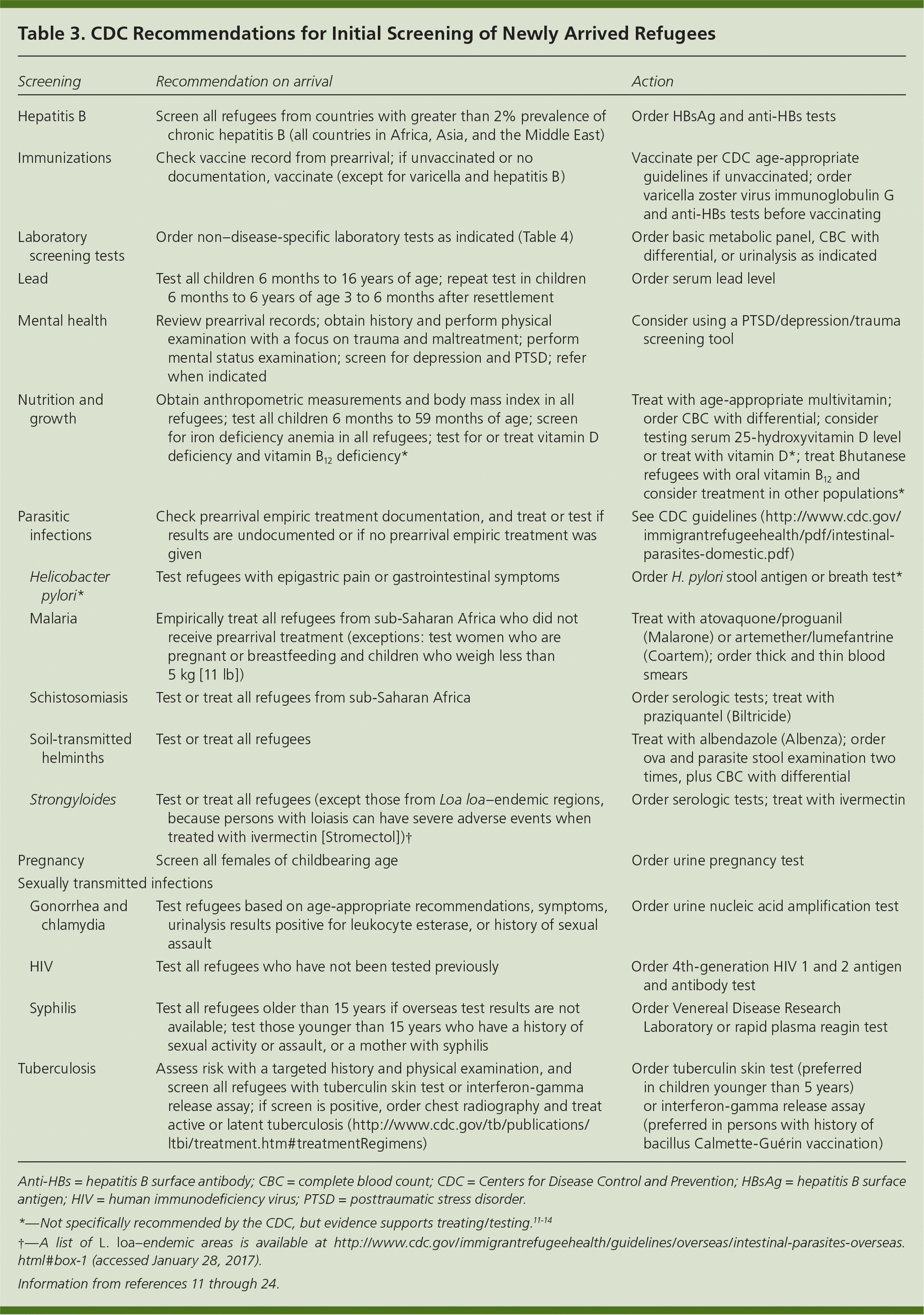
| Screening | Recommendation on arrival | Action | |
|---|---|---|---|
| Hepatitis B | Screen all refugees from countries with greater than 2% prevalence of chronic hepatitis B (all countries in Africa, Asia, and the Middle East) | Order HBsAg and anti-HBs tests | |
| Immunizations | Check vaccine record from prearrival; if unvaccinated or no documentation, vaccinate (except for varicella and hepatitis B) | Vaccinate per CDC age-appropriate guidelines if unvaccinated; order varicella zoster virus immunoglobulin G and anti-HBs tests before vaccinating | |
| Laboratory screening tests | Order non–disease-specific laboratory tests as indicated (Table 4) | Order basic metabolic panel, CBC with differential, or urinalysis as indicated | |
| Lead | Test all children 6 months to 16 years of age; repeat test in children 6 months to 6 years of age 3 to 6 months after resettlement | Order serum lead level | |
| Mental health | Review prearrival records; obtain history and perform physical examination with a focus on trauma and maltreatment; perform mental status examination; screen for depression and PTSD; refer when indicated | Consider using a PTSD/depression/trauma screening tool | |
| Nutrition and growth | Obtain anthropometric measurements and body mass index in all refugees; test all children 6 months to 59 months of age; screen for iron deficiency anemia in all refugees; test for or treat vitamin D deficiency and vitamin B12 deficiency* | Treat with age-appropriate multivitamin; order CBC with differential; consider testing serum 25-hydroxyvitamin D level or treat with vitamin D*; treat Bhutanese refugees with oral vitamin B12 and consider treatment in other populations* | |
| Parasitic infections | Check prearrival empiric treatment documentation, and treat or test if results are undocumented or if no prearrival empiric treatment was given | See CDC guidelines (http://www.cdc.gov/immigrantrefugeehealth/pdf/intestinal-parasites-domestic.pdf) | |
| Helicobacter pylori* | Test refugees with epigastric pain or gastrointestinal symptoms | Order H. pylori stool antigen or breath test* | |
| Malaria | Empirically treat all refugees from sub-Saharan Africa who did not receive prearrival treatment (exceptions: test women who are pregnant or breastfeeding and children who weigh less than 5 kg [11 lb]) | Treat with atovaquone/proguanil (Malarone) or artemether/lumefantrine (Coartem); order thick and thin blood smears | |
| Schistosomiasis | Test or treat all refugees from sub-Saharan Africa | Order serologic tests; treat with praziquantel (Biltricide) | |
| Soil-transmitted helminthes | Test or treat all refugees | Treat with albendazole (Albenza); order ova and parasite stool examination two times, plus CBC with differential | |
| Strongyloides | Test or treat all refugees (except those from Loa loa–endemic regions, because persons with loiasis can have severe adverse events when treated with ivermectin [Stromectol])† | Order serologic tests; treat with ivermectin | |
| Pregnancy | Screen all females of childbearing age | Order urine pregnancy test | |
| Sexually transmitted infections | |||
| Gonorrhea and chlamydia | Test refugees based on age-appropriate recommendations, symptoms, urinalysis results positive for leukocyte esterase, or history of sexual assault | Order urine nucleic acid amplification test | |
| HIV | Test all refugees who have not been tested previously | Order 4th-generation HIV 1 and 2 antigen and antibody test | |
| Syphilis | Test all refugees older than 15 years if overseas test results are not available; test those younger than 15 years who have a history of sexual activity or assault, or a mother with syphilis | Order Venereal Disease Research Laboratory or rapid plasma reagin test | |
| Tuberculosis | Assess risk with a targeted history and physical examination, and screen all refugees with tuberculin skin test or interferon-gamma release assay; if screen is positive, order chest radiography and treat active or latent tuberculosis (http://www.cdc.gov/tb/publications/ltbi/treatment.htm#treatmentRegimens) | Order tuberculin skin test (preferred in children younger than 5 years) or interferon-gamma release assay (preferred in persons with history of bacillus Calmette-Guérin vaccination) | |
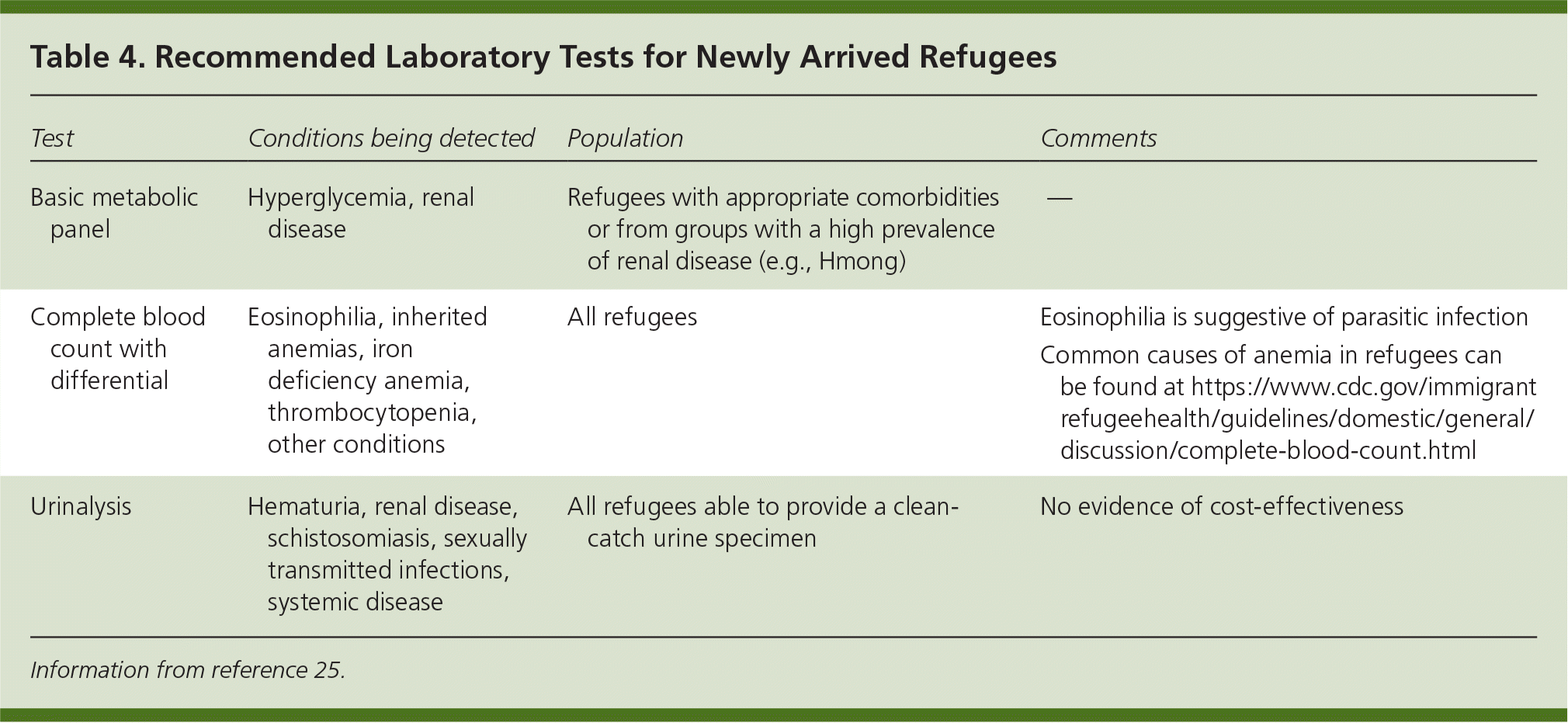
| Test | Conditions being detected | Population | Comments |
|---|---|---|---|
| Basic metabolic panel | Hyperglycemia, renal disease | Refugees with appropriate comorbidities or from groups with a high prevalence of renal disease (e.g., Hmong) | — |
| Complete blood count with differential | Eosinophilia, inherited anemias, iron deficiency anemia, thrombocytopenia, other conditions | All refugees | Eosinophilia is suggestive of parasitic infection Common causes of anemia in refugees can be found at https://www.cdc.gov/immigrantrefugeehealth/guidelines/domestic/general/discussion/complete-blood-count.html |
| Urinalysis | Hematuria, renal disease, schistosomiasis, sexually transmitted infections, systemic disease | All refugees able to provide a clean-catch urine specimen | No evidence of cost-effectiveness |
There is geographic variability in who provides the initial examination. To avoid redundancy, it is important when seeing a refugee patient for the first time to ascertain whether the initial examination has already been completed. If it has, records should be requested from the health department; some health departments are responsible for screening, but not follow-up.
Common Issues in Primary Care
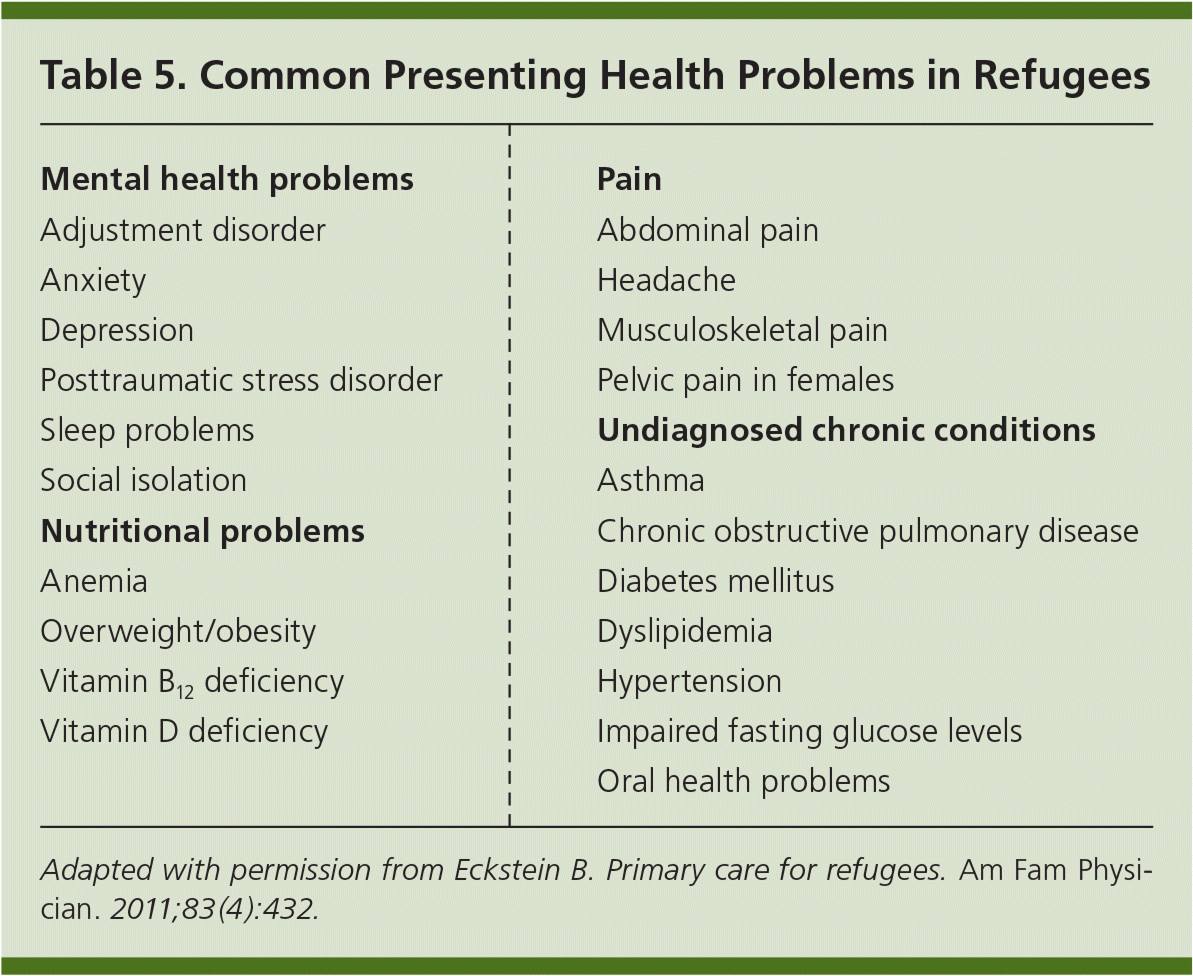
| Mental health problems |
| Adjustment disorder |
| Anxiety |
| Depression |
| Posttraumatic stress disorder |
| Sleep problems |
| Social isolation |
| Nutritional problems |
| Anemia |
| Overweight/obesity |
| Vitamin B12 deficiency |
| Vitamin D deficiency |
| Pain |
| Abdominal pain |
| Headache |
| Musculoskeletal pain |
| Pelvic pain in females |
| Undiagnosed chronic conditions |
| Asthma |
| Chronic obstructive pulmonary disease |
| Diabetes mellitus |
| Dyslipidemia |
| Hypertension |
| Impaired fasting glucose levels |
| Oral health problems |
GENERAL APPROACH
The practice of cross-cultural medicine can improve the physician-patient relationship and help transcend common barriers to care. Cross-cultural barriers may involve communication challenges stemming from language and cultural differences, and culturally based explanatory models of disease 29–31 (Table 632–36 ). All refugees have the right to a trained interpreter for medical visits, and clinics are responsible for arranging these services.11,37 Physicians should routinely inquire about the use of traditional, folk, or alternative treatments. Conversations about obtaining and using insurance, filling prescriptions, making appointments, and the roles of primary care and subspecialty care are important and may require additional resources, such as case management or health navigators.
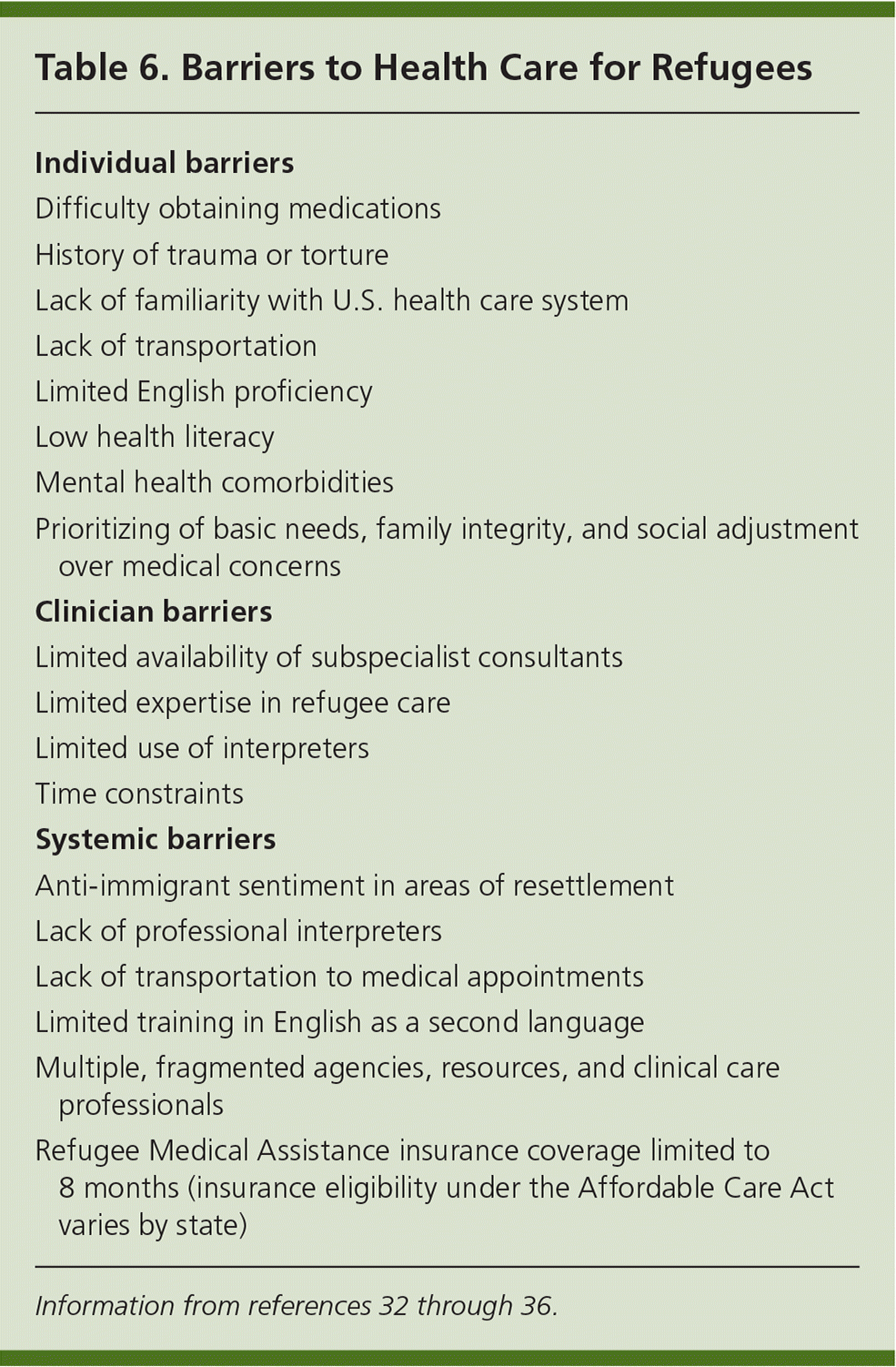
| Individual barriers |
| Difficulty obtaining medications |
| History of trauma or torture |
| Lack of familiarity with U.S. health care system |
| Lack of transportation |
| Limited English proficiency |
| Low health literacy |
| Mental health comorbidities |
| Prioritizing of basic needs, family integrity, and social adjustment over medical concerns |
| Clinician barriers |
| Limited availability of subspecialist consultants |
| Limited expertise in refugee care |
| Limited use of interpreters |
| Time constraints |
| Systemic barriers |
| Anti-immigrant sentiment in areas of resettlement |
| Lack of professional interpreters |
| Lack of transportation to medical appointments |
| Limited training in English as a second language |
| Multiple, fragmented agencies, resources, and clinical care professionals |
| Refugee Medical Assistance insurance coverage limited to 8 months (insurance eligibility under the Affordable Care Act varies by state) |
INFECTIOUS DISEASES
Because of high prevalence in their countries of origin and the circumstances of their migration, some refugees arrive in the United States with higher risks of tropical and infectious diseases, such as tuberculosis, hepatitis A and B, human immunodeficiency virus infection, malaria, parasitic infections, and sexually transmitted infections. Thus, they are screened and treated on departure and arrival. Pre- and postmigration screening and treatment for infectious diseases have resulted in low rates (0.4%) of inadmissible medical conditions.37 However, physicians should have a high level of suspicion when refugee patients present with clinical signs and symptoms consistent with imported communicable diseases, even if they occur months to years after resettlement. Malaria should be considered in refugees from endemic regions who present with fever.11 Reactivation of tuberculosis should be considered in refugees presenting with suggestive signs and symptoms. The highest risk of reactivation occurs in the first few years after arrival, with 50% of cases occurring in the first five years after resettlement.11,27
ORAL HEALTH
Dental care is often neglected in refugees, and dental problems may be related to dietary issues, poor access to oral health services, or a history of torture or trauma.39,40 An oral health examination is recommended, with appropriate referrals, when necessary. Physicians should be aware of the potential oral health effects acculturation may have—including exposure to a Western diet high in sugar—and counsel patients appropriately.41–43
CHRONIC PAIN AND MUSCULOSKELETAL SYMPTOMS
Studies have found rates of chronic pain as high as 65% to 83% in refugees (compared with 22% in the general population).30 Common symptoms in refugees include generalized musculoskeletal and body pain; headaches; and abdominal, pelvic, and chest pain.30 Refugees who have pain should undergo a thorough history and examination, and if no organic causes are detected, clinicians should consider a history of trauma as the potential cause. One study found that 78% of tortured patients had persistent pain in one or more locations; these were not predominantly psychological manifestations, but were often physical consequences of trauma.31,44 Posttraumatic stress disorder (PTSD), depression, and somatization also contribute to chronic pain.30 Physicians should consider a range of treatment modalities, including physical therapy, acupuncture, trigger point injections, massage, antidepressants, cognitive behavior therapy, and relaxation therapy.31
MENTAL HEALTH
The mental health needs of refugees may be substantial and are likely to present in the primary care setting.45–47 The specific types of mental health conditions are strongly influenced by the migration history and the type and duration of exposure to adversity encountered before, during, and after a refugee's flight.48 Compared with the general population, refugees have higher rates of mood disorders, anxiety, and PTSD. They may present with somatic symptoms, sleep disorders, fatigue, paranoia, or suicidal thoughts.45 Resettled refugees are 10 times more likely than the rest of the population to have PTSD, and depression is a common comorbidity.40,49–51 PTSD may present years after arrival, even long after resettlement.51,52 There are multiple instruments and tools to screen for depression, anxiety, and PTSD.15,53 Two well-known tools that are validated in several languages and used in refugee populations are the Hopkins Symptom Checklist-25 (http://hprt-cambridge.org/screening/harvard-trauma-questionnaire/) and the Refugee Health Screener (http://refugeehealthta.org/2012/02/08/refugee-health-screener-15-rhs-15/). Some of these specialized questionnaires may require a fee to use (see websites for information on purchasing), but routinely used primary care screening tools for PTSD, anxiety, and depression may be sufficient (although not necessarily validated in refugee populations or in different languages).
Referral is recommended to health care professionals who specialize in providing psychological assistance to immigrants and refugees, and who offer language-congruent and culturally appropriate care.
TRAUMA AND TORTURE
Mental health problems may be exacerbated by a patient's history of trauma or torture. PTSD is more common in refugees who had been exposed to torture and violence. Trauma and torture are common among refugees; multiple studies show the prevalence to be more than 50%,51,54–57 and a recent analysis by the Center for Victims of Torture estimated that 1.3 million refugees who survived torture currently live in the United States.58
According to a study of immigrants to the United States who had experienced political violence or persecution, only 3% ever told a doctor about it, and none were ever asked by a physician if they were affected by torture.59 Although screening for such trauma is a sensitive issue,60 uncovering a history of exposure to violence may make it easier to understand a patient's somatic symptoms and may relieve some of the stress of assimilation.61,62 The CDC recommends asking two questions: “Were you ever a victim of violence in your former country?” and if yes, “Would you like to describe what happened to you?” 17 A commonly used screening tool is the Harvard Trauma Questionnaire, which has been translated into six languages (http://hprt-cambridge.org/screening/measuring-trauma-measuring-torture/).
CHRONIC CONDITIONS
Chronic, noncommunicable diseases have a high prevalence among refugees.63 This is true not only in those from higher-income countries, but also in refugees from less developed regions; this reflects the increasing worldwide burden of these conditions. More than 50% of adult refugees in the United States have at least one non-communicable disease, and 9.5% have three or more.63 Noncommunicable diseases vary widely among specific populations, but conditions commonly identified in refugee populations include anemia, hypertension, impaired fasting glucose levels, micronutrient deficiencies, chronic pulmonary disease, and overweight or obesity.11–13,16,63–66
Health Maintenance
Refugees from countries with inadequate or inefficient health systems may be missing immunizations and routine recommended screenings for cancer and chronic diseases. They may be unaccustomed to the concepts of chronic disease management and preventive care.16 It is not necessary to complete all routine health maintenance during the first visit, but it should be addressed in subsequent encounters. Attention to women's health, family planning, cancer screening (breast, colon, and cervical), oral health, vision, and chronic disease screening (hyperlipidemia, diabetes mellitus, hypertension, and hepatitis C) will help identify and address previously unmet health care needs.31 Age-appropriate immunizations should be administered after a thorough review of available records. If records are unavailable, it is more cost-effective to administer vaccines rather than obtain titers, with the exception of varicella and hepatitis B; for these diseases, serology testing and vaccinating only if nonimmune are more cost-effective.11,16
Final Comment
Despite the challenges, working with refugees is highly rewarding and offers an opportunity to not only provide clinical care, but also be inspired by persons who have shown great perseverance and resilience against many odds. eTable B lists useful resources for family physicians who care for refugee patients.
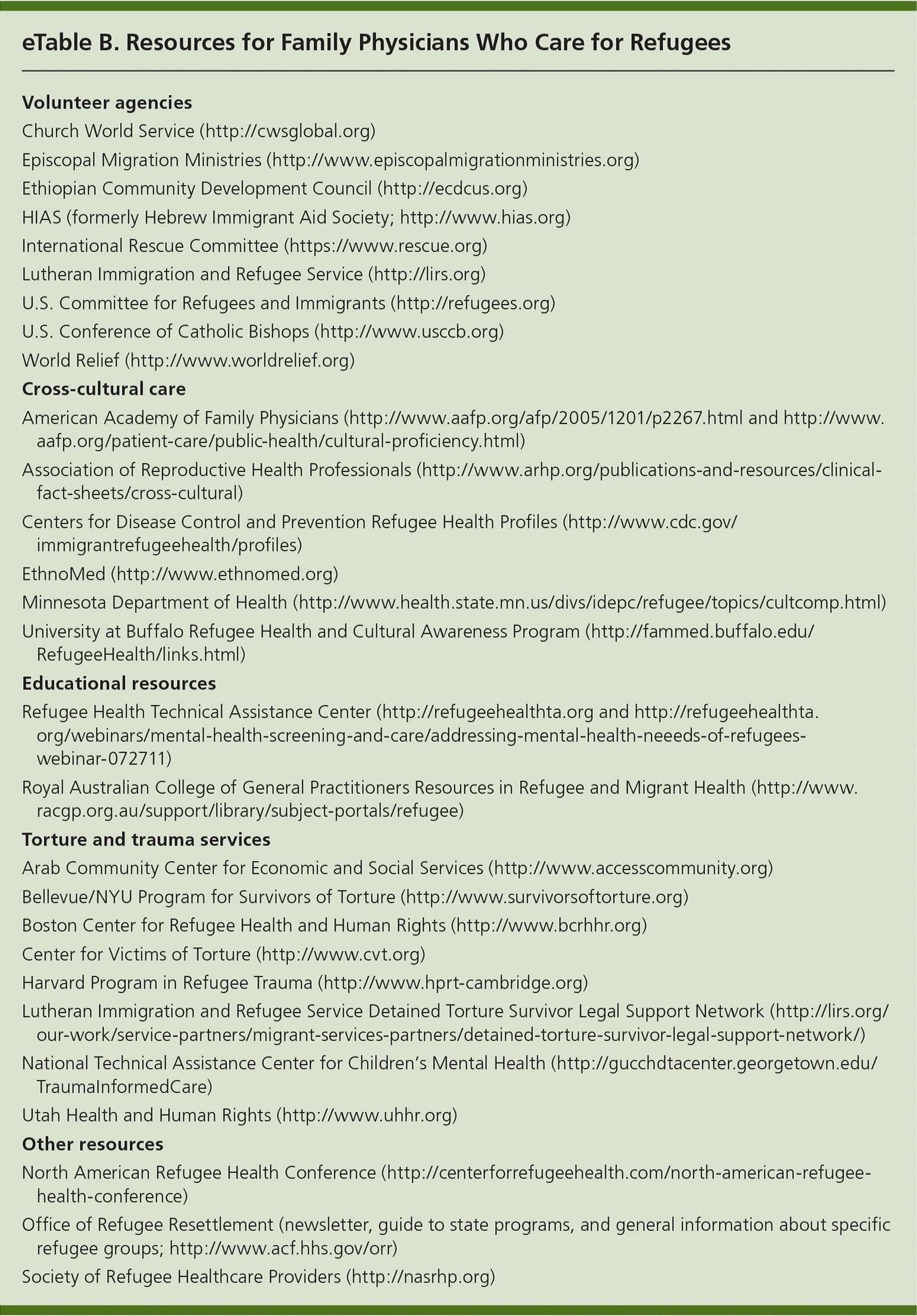
| Volunteer agencies |
| Church World Service (http://cwsglobal.org) |
| Episcopal Migration Ministries (http://www.episcopalmigrationministries.org) |
| Ethiopian Community Development Council (http://ecdcus.org) |
| HIAS (formerly Hebrew Immigrant Aid Society; http://www.hias.org) |
| International Rescue Committee (https://www.rescue.org) |
| Lutheran Immigration and Refugee Service (http://lirs.org) |
| U.S. Committee for Refugees and Immigrants (http://refugees.org) |
| U.S. Conference of Catholic Bishops (http://www.usccb.org) |
| World Relief (http://www.worldrelief.org) |
| Cross-cultural care |
| American Academy of Family Physicians (https://www.aafp.org/afp/2005/1201/p2267.html and https://www.aafp.org/patient-care/public-health/cultural-proficiency.html) |
| Association of Reproductive Health Professionals (http://www.arhp.org/publications-and-resources/clinical-fact-sheets/cross-cultural) |
| Centers for Disease Control and Prevention Refugee Health Profiles (http://www.cdc.gov/immigrantrefugeehealth/profiles) |
| EthnoMed (http://www.ethnomed.org) |
| Minnesota Department of Health (http://www.health.state.mn.us/divs/idepc/refugee/topics/cultcomp.html) |
| University at Buffalo Refugee Health and Cultural Awareness Program (http://fammed.buffalo.edu/RefugeeHealth/links.html) |
| Educational resources |
| Refugee Health Technical Assistance Center (http://refugeehealthta.org and http://refugeehealthta.org/webinars/mental-health-screening-and-care/addressing-mental-health-neeeds-of-refugees-webinar-072711) |
| Royal Australian College of General Practitioners Resources in Refugee and Migrant Health (http://www.racgp.org.au/support/library/subject-portals/refugee) |
| Torture and trauma services |
| Arab Community Center for Economic and Social Services (http://www.accesscommunity.org) |
| Bellevue/NYU Program for Survivors of Torture (http://www.survivorsoftorture.org) |
| Boston Center for Refugee Health and Human Rights (http://www.bcrhhr.org) |
| Center for Victims of Torture (http://www.cvt.org) |
| Harvard Program in Refugee Trauma (http://www.hprt-cambridge.org) |
| Lutheran Immigration and Refugee Service Detained Torture Survivor Legal Support Network (http://lirs.org/our-work/service-partners/migrant-services-partners/detained-torture-survivor-legal-support-network/) |
| National Technical Assistance Center for Children's Mental Health (http://gucchdtacenter.georgetown.edu/TraumaInformedCare) |
| Utah Health and Human Rights (http://www.uhhr.org) |
| Other resources |
| North American Refugee Health Conference (http://centerforrefugeehealth.com/north-american-refugee-health-conference) |
| Office of Refugee Resettlement (newsletter, guide to state programs, and general information about specific refugee groups; http://www.acf.hhs.gov/orr) |
| Society of Refugee Healthcare Providers (http://nasrhp.org) |
This article updates previous articles on this topic by Eckstein10 and by Gavagan and Brodyaga.67
Data Sources: We searched Medline and PubMed using the keyword refugee(s), alone and with the following terms: health, mental health, torture, chronic disease, screening, infectious disease, oral health, and health system. Another key resource was the CDC website for refugee and immigrant health (http://www.cdc.gov/immigrantrefugeehealth/exams/medical-examination.html). Search dates: April 24, 2016, to October 15, 2016.
Dr. Mishori received a president's grant from the Josiah Macy Jr. Foundation for a refugee health education initiative.
